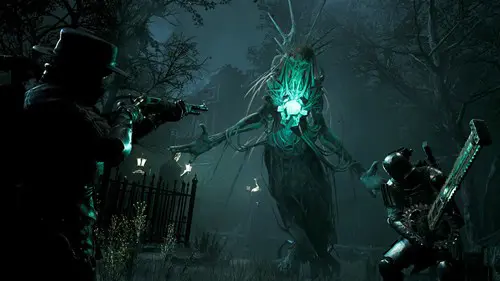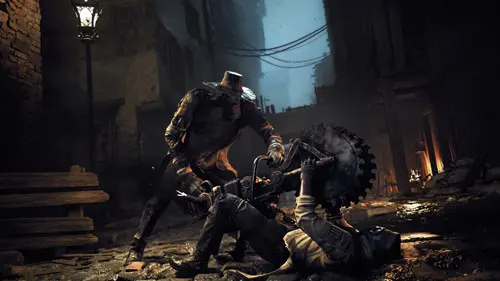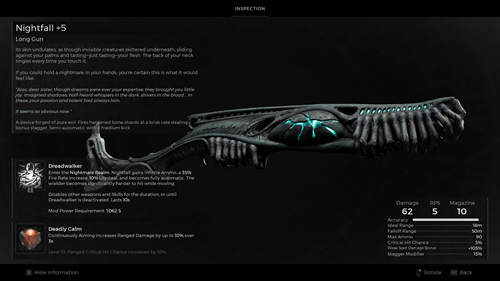Remnant 2 review: Copious co-op challenge
With a shortage of co-op games to play, we need to take what we can get, and Remnant 2 handily fills that role. You’ll find plenty of fun here if that’s all you want, but it’s not quite as masterful as the games it’s so heavily influenced by.

With a shortage of co-op games to play, we need to take what we can get, and Remnant 2 handily fills that role. You’ll find plenty of fun here if that’s all you want, but it’s not quite as masterful as the games it’s so heavily influenced by.
Images courtesy of Gunfire Games
If Remnant 2 flew under your radar until recently, I don’t blame you. This game came out of nowhere for me and I jumped in knowing nothing about the franchise. Remnant 2 promises tough action gameplay, fully-fledged co-op features and a bevy of weapon and character upgrades to keep you grinding away through its sizable campaign. As it turns out, it’s a game right up my street.
As with any big co-op shooter, the devil is in the details. Are the rewards worth the effort it takes to throw yourself through the game’s gauntlet of challenges? Is the co-op tacked on, or is it fully ingrained in the game’s DNA? And is it worth playing solo? The answers to these questions are somewhat mixed.
GGRecon Verdict
With a shortage of co-op games to play, we need to take what we can get, and Remnant 2 handily fills that role. You’ll find plenty of fun here if that’s all you want, but it’s not quite as masterful as the games it’s so heavily influenced by.
Class Warfare
Not long after the tutorial mission you’re presented with a choice of different archetypes - classes that support different playstyles. There’s a medic class, the melee-focused Challenger, Hunter, Gunslinger and Handler, the latter of which comes equipped with an animal companion that can heal you. Each one has its own set of skills to slowly unlock over time. I picked the challenger - I’m a solo player primarily, so the chance to revive myself after going down seemed handy.
That proved to be extremely accurate. Remnant 2 is a difficult game, and the challenge is amplified significantly when you play alone.
In the heart of combat

If you’re playing with friends each class will compliment each other in different ways, but for the most part you’ll still be sticking to your primary weapon and handgun for the majority of combat. Remnant 2 is an action-packed third-person shooter through and through, and keeping your distance from enemies is usually necessary unless you want a quick trip back to the last checkpoint.
The shooting is solid, and guns hit hard and feel strong. They’re snappy too, and it’s fun to quickly whip them out and dispatch enemies in a flurry of bullets. You can only fire them if you scope in, as pressing the trigger while unscoped brings out your melee weapon instead.
The melee gameplay is pretty clunky - despite picking Challenger I relied on range, only resorting to close quarters in a pinch. The controls work well overall though. Sadly there’s no way to remap them on a controller as far as I can tell, so hopefully that’s added in the future.
The rest of your kit is comprised of class-specific abilities and weapon mods, which help flesh out your options in battle. The cooldown on these extra abilities can be pretty brutal though - mods in particular take a long time to regenerate, making building into each the best way of making the most of them. It’s tough to keep a large stash of guns upgraded due to the fairly slow acquisition of resources, meaning you’ll probably have to stick with a smaller number of tried-and-tested favourites.
In the early game enemies often charge at you in hordes, which means a heavy reliance on dodging. The dodge animation is quite slow, and with an over-the-shoulder camera perspective it’s often difficult to tell where attacks are coming from. Sometimes a boss might swing at you 4 or 5 times in a row, almost guaranteeing that you’ll take a hit even if you dodge like crazy. There’s a reason games like Elden Ring pull the camera back to show a little more of whatever’s about to pummel you into submission.
Bosses and Bonfires

The boss fights steadily improve as the game goes on. Most have an impressive visual design, but their movesets can be frustrating and unintuitive. One of the first bosses I encountered sat on a rooftop and threw bombs at me, rendering my shotgun/melee class irrelevant.
Later fights can be gruelling, but you’ll eventually learn patterns and how to exploit them, and figuring them out is as satisfying a puzzle as any other. They demand a lot from you though, especially if you don’t have many consumables. The classic Insta-kill grabs from everyone’s least favourite Dark Souls bosses pop up here, and they’re just as awful. Trial and error will be key for most players, even those well-adjusted to tough action games, and that may turn some away from the game.
Remnant 2 actually takes a lot from those iconic titles, whether it’s resting at bonfire-esque checkpoints or chugging from a limited-use flask. There’s no denying the similarities between the Remnant series and the games that clearly inspired much of its core gameplay. The first few areas even feel reminiscent of Bloodborne’s Yharnam, with its decrepit villages, creepy asylum and unhinged townsfolk.
World-building is less of a focus here, and the story isn’t very gripping. The environments are well-designed but sometimes fail to feel grounded due to how often you’ll travel between worlds. Before you get a chance to understand the area you’re traversing, you’ll be whisked away to a distant land with a completely different vibe and lore, making it hard to feel attached to any in particular.
The tone also switches a lot, darting all over the place from one visual theme to the next before you’ve had a chance to really immerse yourself. You’ll jump between an apocalyptic city, gothic towns, a stone labyrinth and abstract sci-fi worlds, each unique and unexpected, and while they provide a great backdrop for the action they don’t feel very connected.
Perhaps that’s the point - the rapid planet-hopping is clearly meant to keep you on your toes. The swift change of locales does keep the game fresh, and they’re often very pretty, but I’d have liked to be able to learn more about them.
Better with friends?

Remnant 2 makes sensible use of its borrowed mechanics and offers a consistent challenge. It just doesn’t quite stand out as much as it might hope to in the crowd of similar action adventures.
What’ll make Remnant 2 worth it for some is the co-op functionality. This feature is more accessible and integral to the game than the likes of Dark Souls or Elden Ring. There’s a drastic shortage of great co-op games on the market, and while I’m not entirely convinced Remnant 2 is that, multiplayer provides a reason to pick it up for anyone desperate for a new cooperative experience.
Being able to draw enemy aggression away from friends and help each other out means the game is quite a bit less frustrating than going solo, almost certainly making it the optimal way to play. And let’s be honest, anything is more fun when you’re goofing around with a squad.
Interestingly, levels and encounters are procedurally generated for each player. If I didn’t look it up I would’ve had no idea, as they seem handcrafted on the surface. Occasionally you might go off the beaten path and fight a bunch of enemies only to find no reward at the end, but for the most part, the procedural element doesn’t negatively impact things and offers different players their own unique experience for their campaign.
It helps replayability too, but just how effective the procedurally generated content is remains to be seen. As more players get their hands on the game we’ll know for sure how random and varied this content truly is.
Progression is key

Remnant 2 has an array of upgrades to apply to your character over time. You’ll find rings, amulets, relics and other items that apply stat boosts or different effects to your character. Initially, these upgrades don’t feel very meaningful. Finding loot should be a satisfying moment, but it’s hard to care about an additional 1% ranged damage.
You’ll equip it and forget about it, never noticing it in combat. This makes the gameplay loop of exploring and finding loot a lot less exciting in the early game and might turn some people off the game at first.
If you put the time in you’ll definitely be rewarded, but it takes a little while to get there. Weapon mods are a lot more meaty, unlocking powerful effects when loaded into a gun. You can freeze time, pull enemies in with a chain or set them on fire.
Defeating bosses will unlock new weapons with unique effects, enhancing your arsenal the more you play. You can slot a second archetype into your build to gain new skills, unlock traits for minor stat boosts and increase your weapon damage.
You’ll also find mods and other items behind puzzles in the world, and thanks to a lack of hand-holding these puzzles are actually quite satisfying to figure out, making for a nice break between combat. Weirdly, armour upgrades seem non-existent for large portions of the game, and you can’t unequip a piece of armour if it’s the only one you have, meaning I was stuck with the ugly Challenger helmet for far longer than I would’ve liked. More personalisation and armour customisation would’ve gone a long way, but at least we’ve got weapons and mods to hunt down.
The game is very linear so it’s difficult to get lost. That said, there are a couple of moments where it’s not super clear what you’re supposed to do. This is good for building a sense of adventure and mystery, and it’s a lot better than simply directing you towards your objective with quest markers and a path on your minimap - all-too-common features of modern adventure games.

Being so linear means you don’t really have much to explore though - you’re essentially blasting your way through a series of pathways or corridors in most areas, and when you hit a roadblock you don’t have much of an option besides overcoming it.
I reached the end of a dungeon only to find out I couldn’t progress, and to get through I needed multiple coins from an enemy type that only spawned once my first time through that dungeon. I had to backtrack through the place in hopes of stumbling across it again, a mildly annoying excursion that only served to slow the pace of the game. Thankfully, these moments are rare.
The Verdict
With a shortage of co-op games to play, we need to take what we can get, and Remnant 2 handily fills that role. You’ll find plenty of fun here if that’s all you want, but it’s not quite as masterful as the games it’s so heavily influenced by.
Memorable story moments and truly great encounters are few and far between, but it will take you on an enjoyable ride with more than enough action to scratch that particular itch.
When you’re in the chaos of an intense fight the game can be thrilling. It’s relatively bug-free (at least in my experience), combat is snappy and satisfying and the gameplay loop of defeating bosses and growing stronger is always a winner. It’s an imperfect journey that should still appeal to plenty of gamers, and while the boss and level design falls short of the genre’s best, as far as games in the soulsborne style go, you can do far worse than Remnant 2.
3.5
Reviewed on PC. Review code provided by the publisher.
Comments
